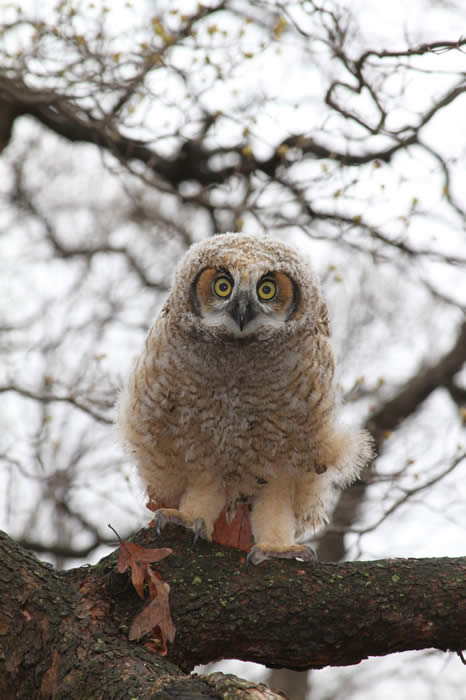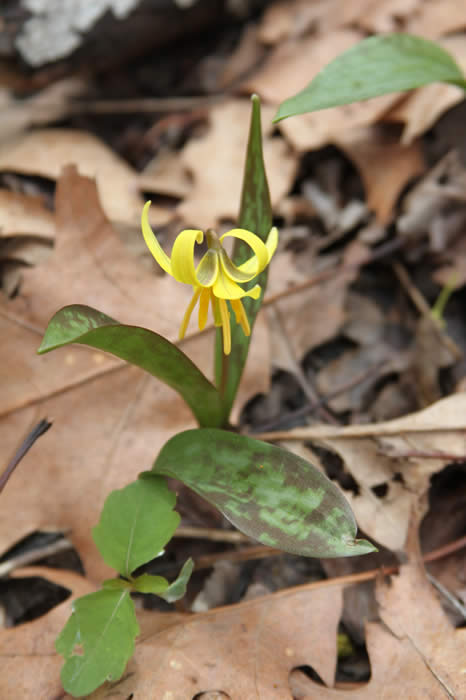The Hudson River Diaries A Compendium of Poetry and Natural History Gleaned from observations in and around Sparkill, New York |
April 2011- Easter Weekend The Great Horned Owl Suite Great horned owls have been nesting in the same site in Tallman State Park for two years now. We keep them under close observation. The nest is located about 40 feet up in an old oak tree at the top of the Palisades. This year (2011) they began nesting on or about January 17, immediately after a major snowstorm. Chicks were first observed poking their tufted feather "ears" above the nest in early March. The larger of the two chicks left the nest around April 10. The smaller chick was seen branching (experimentally leaving the nest) on April 23. We presume he is a male; the other fledgling was much larger, suggesting a female. While branching, the male suddenly flew to the ground in a dramatic flurry. |
During this defensive display, the adolescent spread his wings to make himself look as large as possible, while aggressively clicking his beak. |
A close-up of our friend, who did not perceive us as friendly. |
A short video of his beak-clicking display. |
Another example of defensive display. |
 |
Restored to safety in a tree branch–from which his parents eventually collected him–he glared balefully at us. |
 |
A photograph clearly showing the nictitating membrane that birds of prey used to cover their eyes, protecting them from debris. The left eye is fully covered–the right eye shows the membrane half lowered. |
Waiting for mom and dad |
April is the time of year when the amelanchier, or serviceberry--also known as shadblow, or shadberry--blooms. This bush, which features tough, hard wood, but has extraordinarily delicate blossoms, got its name from the fact that it blooms at about the time that the shad runs take place up rivers in the spring. |
The charmingly droopy blossoms feature five small white petals. |
Local magnolias are also putting on an exuberant show by mid April. |
|
|
The Sparkill Runs through the first gap in the Palisades north of Manhattan. A natural passageway into the rich hinterlands of New York and New Jersey, it was one of the first places Dutch settlers traded with Native Americans for furs. Many of the place names in this area are either Dutch or Native American. The community boasts a large collection of colonial (as well as 18th and 19th century) dwellings. The Sparkill puts on an impressive flow when it rains. Here we see it from the bridge just above Piermont, as it flows towards the Hudson. At this point it wends its way between 19th-century buildings, close to its mouth at the marsh. |
Like many rivers nationwide, the Sparkill has a dam. It lies about a quarter of a mile from where it feeds into the Hudson. Originally constructed to supply electricity for a silk mill that is now a condominium complex, the dam has long outlived its usefulness. Nonetheless, it remains, a serious obstacle to the natural flow of wildlife–for example, migrating eels can no longer move up this creek. Dams of this kind should definitely be removed, but doing so presents considerable political obstacles–in this case, residents around the pond it creates (badly polluted though it is) would almost certainly object. One bright point, however, is that the Sparkill pond provides good habitat for migrating waterfowl, and hosts a thriving population of fish and turtles. |
This is what sunrise looked like on Easter morning, April 2011.Tthere was a great deal of moisture in the air, and the sun had just cleared the tree tops on the south side of the Sparkill Gap. |
Looking north from the south ridge of the Sparkill Gap towards Piermont, Nyack, and the Tappan Zee Bridge. All three landmarks ought to be prominently visible from here, but the Tappan Zee is completely filled with fog on this Easter morning, obscuring everything in a veil of mist. The sun is behind clouds, so the fog is cool, and low in the river basin.
|
The same view, on Dec. 27 of 2010, without the mist. The Tappan Zee Bridge is visible on the far right. The peak rising up to the north of the bridge (middle of photo, on right) is the Hook--a massive escarpment of basalt named from the Dutch "verdrietlg hock" which means "tedious point"--suggesting that navigating past it in sailing vessels was a laborious process. |
A video of the same North view. Some small portions of the town of Piermont can be seen at the bottom of the video. As the sun emerges from behind the clouds on April 24, Easter Sunday, the fog lying low over the Tappan Zee begins to slowly expand and rise in the heat, gradually obscuring the Palisades. During the video, you will see a number of insects flying in front of the screen: this is the first day they have been active this year. |
Eventually, everything but the very top of the hills is obscured.
|
is a spring ephemeral that grows profusely in the area. This specimen found a foothold in a crack in the basalt that forms the Palisades.
|
Claytonia forms a beautiful carpet in the understory for about one brief week each year. |
 |
Erythronium americanum, the trout lily, is another spring ephemeral, with lovely mottled leaves and a graceful nodding flower. They bloom at the same time as the spring beauty, but are not as prolific. |
By Mid-April, Podophyllum peltatum, the May Apple, is also up, and has set flower buds. The fruit of this plant is edible, but animals invariably get to it before I can find any.
|
Lindera benzoin, the common spicebush, is one of the first shrubs to bloom in the understory along the Palisades, creating a pleasing effect. |
Lindera |